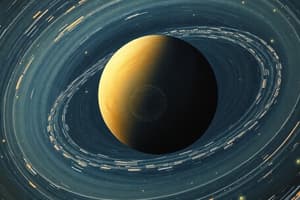Podcast
Questions and Answers
What is the shape of a planet's orbit around the Sun according to Kepler's First Law?
What is the shape of a planet's orbit around the Sun according to Kepler's First Law?
- Hyperbola
- Circle
- Parabola
- Ellipse (correct)
Which point(s) help determine the shape of an elliptical orbit?
Which point(s) help determine the shape of an elliptical orbit?
- Vertices
- Asymptotes
- Apogee and perigee
- Foci (correct)
What is true about a planet's orbital speed according to Kepler's Second Law?
What is true about a planet's orbital speed according to Kepler's Second Law?
- It is constant throughout the orbit
- It varies depending on the distance from the Sun (correct)
- It increases as the planet moves farther from the Sun
- It decreases as the planet moves closer to the Sun
How does the Sun's gravitational pull affect a planet's orbital speed?
How does the Sun's gravitational pull affect a planet's orbital speed?
According to Kepler's Third Law, what is true about the relationship between a planet's orbital size and the time it takes to complete its orbit?
According to Kepler's Third Law, what is true about the relationship between a planet's orbital size and the time it takes to complete its orbit?
How does the distance from the Sun affect a planet's orbital speed and the time it takes to complete its orbit?
How does the distance from the Sun affect a planet's orbital speed and the time it takes to complete its orbit?
Which of the following statements is NOT true according to the information provided?
Which of the following statements is NOT true according to the information provided?
How do rockets put satellites into orbit in space?
How do rockets put satellites into orbit in space?
Why does a satellite placed in orbit above Earth continue to circle the planet indefinitely?
Why does a satellite placed in orbit above Earth continue to circle the planet indefinitely?
What is the main function of satellites in geostationary orbit (GEO)?
What is the main function of satellites in geostationary orbit (GEO)?
How does the speed of satellites in geostationary orbit (GEO) compare to Earth's rotation speed?
How does the speed of satellites in geostationary orbit (GEO) compare to Earth's rotation speed?
Why are geostationary orbit (GEO) satellites used for telecommunication purposes?
Why are geostationary orbit (GEO) satellites used for telecommunication purposes?
Which statement accurately describes the formation of planets in our Solar System?
Which statement accurately describes the formation of planets in our Solar System?
What is the primary factor that causes objects in space to orbit around each other?
What is the primary factor that causes objects in space to orbit around each other?
In our Solar System, which of the following statements is true regarding orbits?
In our Solar System, which of the following statements is true regarding orbits?
What is the relationship between the mass of two orbiting objects and their orbits?
What is the relationship between the mass of two orbiting objects and their orbits?
Which of the following statements is NOT true about orbits, according to the information provided?
Which of the following statements is NOT true about orbits, according to the information provided?
Flashcards are hidden until you start studying




